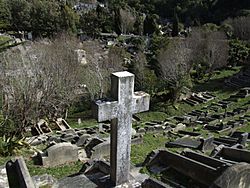Karori Cemetery facts for kids

View of Karori Cemetery
|
|
| Details | |
|---|---|
| Established | 1891 |
| Location |
Karori
|
| Country | New Zealand |
| Owned by | Wellington City Council |
| Footnotes | cemeteries database |
Karori Cemetery is New Zealand's second largest cemetery. It is located in the Wellington suburb of Karori.
Contents
History of Karori Cemetery
Karori Cemetery opened in 1891. It was created because the older Bolton Street Cemetery was getting too full.
In 1909, Karori Cemetery got New Zealand's first crematorium. A crematorium is a place where bodies are turned into ashes. This crematorium is still used today. It is the oldest one in Australasia, which includes Australia and New Zealand.
By the 1950s, Karori Cemetery was almost full. So, Makara Cemetery became Wellington's main burial place. Today, new burials at Karori only happen in special family plots that were bought a long time ago. They also happen in children's plots and for ashes.
The Karori Crematorium and Chapel are very important historical buildings. They are listed as Class I by Heritage New Zealand.
About Karori Cemetery
This large cemetery covers almost 40 hectares (about 0.4 square kilometers). More than 83,000 people have been buried here over the years.
War Graves and Memorials
Karori Cemetery has special sections for soldiers who died in World War I and World War II. There are 268 Commonwealth soldiers from World War I buried here. Many of them died at nearby army camps. There are also 123 soldiers from World War II. A few soldiers from Norway and France are also buried here.
The Commonwealth War Graves Commission (CWGC) is an organization that looks after war graves. They put up a special plaque here. It remembers 15 New Zealand soldiers from World War II whose ashes were scattered after cremation. This plaque is on a wall in the Services section.
The CWGC also built the Wellington Provincial Memorial. It is a marble arch that connects the two war sections. This memorial has the names of soldiers from the Wellington area. These soldiers died in the World Wars but have no known grave.
Notable People Buried Here
Many interesting people are buried at Karori Cemetery. Here are a few of them:
- Lily Atkinson (1866–1921): She was a great speaker who fought for women's right to vote (a suffragist). She also worked to reduce alcohol use. Lily led important groups that helped women and children.
- Suzanne Aubert (1835–1926): She was a special nun who started a group called the Daughters of Our Lady of Compassion. She is considered a saint.
- Albert Henry Baskerville (1883–1908): He helped organize a famous rugby tour. His team, the 'All Golds,' traveled to Great Britain and Australia.
- William Thomas Beck (1865–1947): He was a New Zealand Army officer. He was one of the first New Zealanders to land at Gallipoli during World War I on April 25, 1915.
- John Duthie (1841–1915): He was a successful businessman and a politician. He even served as the Mayor of Wellington from 1889 to 1890.
- Peter Fraser (1884–1950): He was a very important leader. Peter Fraser served as the Prime Minister of New Zealand. There is a special memorial for him here.
- John Hosking (1854–1928): He was a judge in the Supreme Court.
- Joseph Kinsey (1852–1936): He was a businessman from Christchurch. He was also known for collecting things and giving money to good causes (a philanthropist).
- Cybele Kirk (1870–1957): She was an educator who taught others. Like Lily Atkinson, she also fought for women's right to vote and worked to reduce alcohol use.
- Charles Morison (1861–1920): He was a lawyer in New Zealand.
- Elizabeth Pinfold (1859–1927): She received a special award called the Belgian Queen Elisabeth Medal.
- Mary Player (about 1857–1924): She worked as a servant and a midwife, helping mothers with their babies. She also helped people in need and worked for women's rights.
Images for kids
-
Prince Philip, Duke of Edinburgh, visited Karori Cemetery on December 31, 1953. This was a week after the sad Tangiwai disaster.


